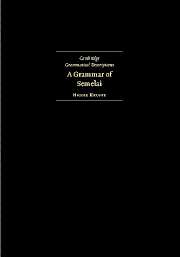Book contents
- Frontmatter
- Dedication
- Contents
- Tables and figures
- Preface
- Acknowledgements
- Abbreviations and conventions
- Maps
- 1 Semelai
- 2 Phonology and phonotactics
- 3 Morphology
- 4 Word classes
- 5 The verb
- 6 Pronouns: personal, ignorative, and demonstrative
- 7 The noun phrase
- 8 Prepositions and the prepositional phrase
- 9 Grammatical relations, constituent order and coding strategies
- 10 Basic clauses
- 11 Complex clauses
- 12 Expressives
- 13 The quotative marker, interjections and discourse clitics
- 14 Texts
- Vocabulary
- References
- Index
11 - Complex clauses
Published online by Cambridge University Press: 05 November 2014
- Frontmatter
- Dedication
- Contents
- Tables and figures
- Preface
- Acknowledgements
- Abbreviations and conventions
- Maps
- 1 Semelai
- 2 Phonology and phonotactics
- 3 Morphology
- 4 Word classes
- 5 The verb
- 6 Pronouns: personal, ignorative, and demonstrative
- 7 The noun phrase
- 8 Prepositions and the prepositional phrase
- 9 Grammatical relations, constituent order and coding strategies
- 10 Basic clauses
- 11 Complex clauses
- 12 Expressives
- 13 The quotative marker, interjections and discourse clitics
- 14 Texts
- Vocabulary
- References
- Index
Summary
In this chapter, syntax at the level above the simple clause is examined, in other words, sentences comprising combinations of simple clauses. Relative clauses, where a clause modifies a noun, are discussed in §11.1. This is followed by a discussion of complementation, where a complement clause fills a core argument position, A, S or O, in a higher clause (§11.2). The discussion then turns to the three constructions where a clause functions to modify a VP or a proposition: serial verb constructions (§11.3), the concatenation of independent clauses (§11.4), and connective clauses (§11.5).
An areal feature of South-east Asian languages is the general absence of formal signalling to code the conjoining or embedding of clauses in complex constructions, resulting in a low level of structural difference. For the most part, in Semelai the various complex sentences simply consist of the unmarked paratactic and, to a lesser extent, the hypotactic concatenation of two or more clauses. Note that although the distinction can be difficult to establish in certain cases, there is in principle a distinction between the simple concatenation of independent clauses (§11.4) and serialised verb constructions (§11.3).
A note is in order on the analytic means of distinguishing the covertly combined clauses. Decisions were made in accordance with the intuitions of the Semelai speakers, phrase and clause level pauses, and intonation contours.
- Type
- Chapter
- Information
- A Grammar of Semelai , pp. 339 - 395Publisher: Cambridge University PressPrint publication year: 2004

